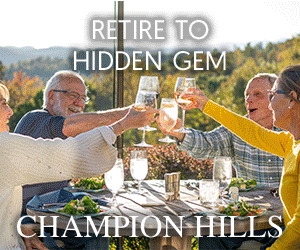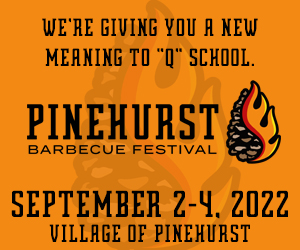By DAVID DROSCHAK
Few golf courses stir up emotions for Webb Simpson like Pinehurst No. 2. His family owns a home in the area, he’s a huge fan of Donald Ross layouts and as a youngster was a standard barrier for Tom Watson’s group during the 1999 U.S. Open.
Simpson was dejected when he failed to qualify for the national championship of golf when it returned to the famed resort course in 2005. So, when the USGA announced a few years ago Pinehurst would be hosting its third Open in 15 years, Simpson was determined to be there.
As the 2012 U.S. Open champion, the former Wake Forest All-American and Raleigh native will not only be playing but likely one of the favorites as the focus shifts from the high rough of Merion Golf Club and Justin Rose’s victory to Pinehurst No. 2 and its sandy waste areas, native wire grasses, greenside hollows and swales — and those tricky and treacherous Ross putting surfaces.
“It seemed like 2014 would never come, but it’s only a year away. I’m excited,” Simpson said. “Pinehurst No. 2 is just the epitome of a golf course that is really straight in front of you. There are no tricks about it. You hit a good shot you’ll get rewarded, you hit a bad shot you’ll get penalized. There’s nothing lucky or unlucky about it. I love Pinehurst golf.”
The No. 2 course was a unique U.S. Open venue before the course changes by architects Bill Coore and Ben Crenshaw as the USGA relented some by bringing the championship to the South, where the potential to grow high rough would be sacrificed.
Now, the new “throwback look” will take that risk a step further, with the historic U.S. Open doubleheader in consecutive weeks to include the U.S. Women’s Open. Both championships will be played with zero rough for the first time ever.
The notion that 80 percent of the players may be hitting fairway approach shots and not hacking out of a forest of rough may raise some eyebrows from Open golfing purists.
“Your chance of getting a few of those ‘green light lies’ at Pinehurst is going to be greater versus always being in rough where you’re going to have grass between your club and ball, and not being able to control your distance or your spin,” said USGA Executive Director Mike Davis said.
But don’t bet on a score of 10-under-par winning the 2014 Open just yet. Pinehurst’s defense – its turtleback greens and short-game decision-making process for players – remain as formidable and mentally taxing as ever.
“The difference between Merion and Pinehurst No. 2 is they’re different styles of short games,” said David Orr, the putting and short-game coach for current Open champion Rose. “At Merion and courses in the Northeast you try to hit soft shots out of the rough to firm greens. In Pinehurst, they will be closely mowed, tight lies, more of a nipping and pinching type of wedge game, or even using a putter off the green. You have to adjust what’s in the bag and what kind of shot style you can hit. It’s definitely an adjustment.”
Believe him or not, Davis said the USGA is not concerned about scoring at U.S. Opens, only testing all of the abilities of the best players – from physical to emotional challenges over 72 holes.
“Mother Nature can give you certain conditions where it is either going to make it much easier or it make it much harder,” Davis said. “My read on Pinehurst is you could see 10, 11 or 12-under win if we are unlucky and we get some storms and it softens up the greens and they can throw darts at them, but I can see where 3 or 4-over would win if it happens to be firm. In either case the USGA wouldn’t have done anything differently; it was what Mother Nature would have done.
“If 10-under is the winning score and the golf course played properly, in other words it was a difficult test and a fair test, then that’s really what we’re looking for, trying to identify the best player that week. We want to have it hard – that is kind of the trademark of the U.S. Open – but I’m committed to the fact that we don’t want to try to trick up Pinehurst No. 2 just to have a higher score winning.”
Davis admits it will be a “wider Pinehurst” in 2014, but wayward shots off the green fairways will find trouble, or maybe not. A haphazard display of native wire grasses, or rough sand, or a fallen pine cone or pine needle, may interfere with a golfer’s approach, or golfers may have a clear path to the green from hard-pan sand.
There will be no “prepping” of the sandy waste areas at No. 2, Davis said, the USGA opting for a “natural” test out of the sand.
“We’re going to make sure those sandy areas have all kind of different shots,” Davis said. “If you hit your ball into one of those areas you are not always going to like what you get. This go-around players are going to encounter a lot more variety when they miss a fairway and sometimes it is going to be harder, when you are in a footprint, than if they were just in Bermuda grass or if your ball is right up against the wire grass, but if you are on hard-pan, for a touring pro, that’s really not that hard a shot. It’s going to be a little bit of a crapshoot. They are not going to know what they are going to get until they get to their ball.”
This U.S. Open venue has produced record crowds in the past, numbers approaching 50,000 spectators a round. A lack of rough may even affect the fans, since some of the viewing areas may be pushed back or altered.
“Our goal is to rope a course so that we keep balls inside the ropes; in other words, play safe in the arena,” Davis said. “Because any time a ball gets outside the ropes, funny things happen. You either get trampled rough or having to move a bunch of spectators or anything you might be in a ton of footprints.
“So, I do think you will see the roping wider. When that ball gets to some of that hardpan, it rolls and it rolls a long way. When you hit Bermuda rough, it stops quickly. So I think there will be a different roping plan. But we are going to be very considerate and thoughtful when it comes to making sure that it’s a good experience for the spectators. I know that our staff has thought through grandstand locations and they have thought through making sure there are quite a few good vantage points, but it will be slightly different.”
With more than 7,000 volunteers already amassed, and Tiger and Phil having played well here before, the anticipation of the Opens – on and off the course – for one of more historic golfing Meccas in the nation will become palpable with each passing day.
“Next year will mark the seventh and eighth USGA championships to be conducted on Pinehurst No. 2, and Pinehurst No. 2 will become the only venue to have hosted all three of our Open Championships and our men’s and women’s amateur championships,” Davis said. “We appreciate the support we have always received from the people of North Carolina, whether it’s the special memories that have happened here inside the ropes as with Payne Stewart in 1999 to the record crowds and hospitality sales in 2005. Pinehurst has become the benchmark for our championships.”
















